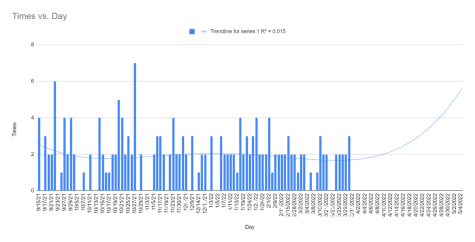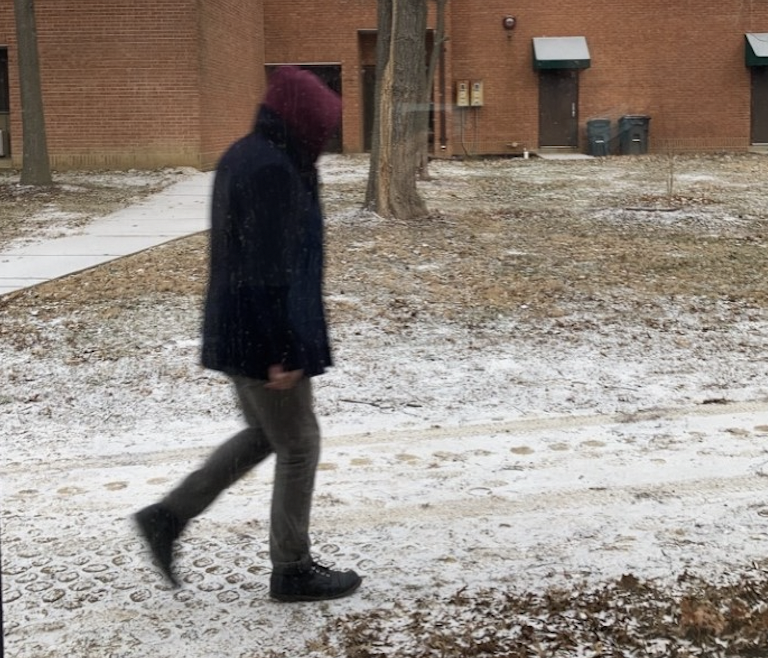Bussen in the Wild
May 6, 2022
ABSTRACT
This study tracks all valid sightings of the organism known as Bussen (bestia bussenus) in the wild as seen from room 400 [science wing, hence the science]. Results have been verified by numerous witnesses for each sighting, and recorded for every day classes were in session. This paper does not seek to elicit the reason for the sightings, only to track the beast in its natural habitat in order to further understand it and prepare defenses if it is aggressive.
INTRODUCTION
Students of French are rarely distracted; however, repeated anomalous sightings of a hooded, hulking beast ambling past the window of room 400 piqued their scientific curiosity. Could this be the actual Bigfoot/Sasquatch/Yeti/Abominable Snowman in Missouri? How does this beast survive the rigor of the seasons? Where was it going? How often would it appear? Would this beast be a threat to our junior schoolers? Would it seek out seafood ravioli in a creamy lobster sauce for nourishment (not found in the wild), or does it eat squirrels and geese? Would it terrorize visiting shadows? Is it an invasive species? How deep is the threat to our Priory way of life? Can we coexist?
In order to give their all to French and decrease the distracting existential dread that these questions elicit, students channeled their terror into quantified sightings of the mysterious beast (later identified and heretofore referenced as bestia bussenus of the homo sapien variety).
MATERIALS AND METHODS
French II, French III, French IV, and AP French served as scientific observers of bestia bussenus. In order to keep the study random to best observe the habits of bestia bussenus, observations were made during class sessions (at varying times of day), verbally indicated to study leader (Swigelson) as “Bussen in the wild,” after which study leader would denote the daily tally on a whiteboard and later record into a spreadsheet (below). This occurred during each class meeting from 15 September 2021 to May 2022 .
RESULTS

Bestia bussenus exhibited erratic frequency near equinoxes and times of seasonal change, averaging two sightings per day with a peak sighting of 7 and a lowest sighting of 0.
DISCUSSION
There have been numerous “_______ in the wild” sightings, such as Vern in the wild, Mr. Clark in the wild, golf cart in the wild, or a fairly regular Mohrmann in the wild. However, none have been as scientifically meaningful as Bussen in the wild, therefore we limited our study thus. While this study seeks only to observe bestia bussenus in the wild, a few conclusions may be drawn from the data. First, the beast is harmless to others. While its surliness and reclusive nature suggest an underlying defensive nature, it is not a threat (to anyone, ever), shows no signs of aggression, and could best be described as meek and reclusive. The beast is reactive to outside stimuli and showcases strong adaptability, and this is evidenced by its changing accoutrements. It is usually hooded to protect its delicate head, which is covered with a soft, non-protective fuzz susceptible to the elements if left uncovered. The beast does not make eye contact, and ambles at a moderate pace. Observants conclude that this is due to the advanced age of the beast and can thus infer that were it at an earlier stage in development, it would move significantly more rapidly. Through observation and detached scientific analysis, observers were able to classify the beast as non-threatening and even pitiable. Investigations are being made into the possibility of taming it, as it cannot be used for its (lack of) fur.
ACKNOWLEDGEMENTS
Thanks to the French students of Saint Louis Priory School, whose observational skills are second only to their willingness to avoid existential dread–whether in the form of classwork or the threat from an invasive species–and have dedicated their energies to the pursuit of science. Special thanks to senior JP Schuster, lab tech, who created the data sheet and graph. His work is and will remain unpaid.
